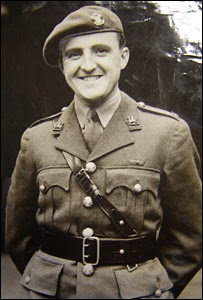49 (West Riding) Division
.jpg)
The 49 (West Riding) Division was committed into action at an early stage of the war when two brigades of the Division participated in an attempt of the 15th to 17th April 1940 to take the Norwegian ports of Trondheim and Narvik back from the control of the occupying German Army. The landings were a disaster and the units were withdrawn in May.
After the Norwegian landings, the 146 and 147 Brigades were transferred and stationed in Iceland, and it was from here that the famous Polar bear on an ice floe insignia originated. The third Divisional brigade, the 148th was reassigned as a training battalion outside of the 49th Division.
1942 saw the Division transferred back to the UK with the incorporation of 70th Brigade (reallocated from the disbanded 23 (Northumbrian) Division) into her ranks.
In the immediate aftermath of D Day, the 49 (West Riding) Division moved to Normandy as part of XXX Corps. After engaging the enemy, it was the traitorous British broadcaster William Joyce, better known as 'Lord Haw Haw' who referred to the Division as 'the Polar Bear Butchers', as a consequence of their reputation for tenacity and aggression in the field. Soldiers of the 49 Division took a grim pride in this epithet as evidenced by a Christmas card produced in 1944.
After the Normandy campaign, the 49th saw further action, most notably in the Arnhem region, as part of the First Canadian Army fighting in support of 'Operation Market Garden'.
The 49 (West Riding) Division is also a fundamental part of this narrative as after the disbandment of the 59 (Staffordshire) Division in August 1944, my Grandfather was transferred to the 11th Battalion Royal Scots Fusiliers (R.S.F.) which formed one infantry Division of 147 Brigade within the 49 (West Riding) Division.
59 (Staffordshire) Division
Positioned in the centre of the line of the Pomegranate front.
A follow-up formation described at length on this site.
53 (Welsh) Division

In many aspects, the World War II history of the 53 (Welsh) Division runs parallel to that of the 59 (Staffordshire) Division. Part of the Territorial Army from 1921 it was mobilised at the outbreak of the war in 1936 and detailed initially to protect the ports of South Wales. However, in October 1939 the 53rd transferred to Northern Ireland where it trained and also maintained a keen eye on the activities south of the border. In November 1941 it was replaced by the 59 (Staffordshire) Division who you may recall were dismayed to surrender their new transport and armour in the North East of England only to take on the tired equipment of 53rd (Welsh) in Ulster!
As with 59th, training continued apace with the Division spending a further period of time in the Welsh borders before being moved down into Kent to defend the south coast during the 1942-1943 period. Reorganisation occurred in October 1943, with the 71st Infantry Brigade taking the place of the 159th Infantry Brigade who became part of 11th Armoured Division. The Division then concentrated those aspects of training that would serve them best when the time came to take the fight to France.
The 53 (Welsh) Division landed in Normandy as a follow-up formation under the command of VII Corps on 28th June 1944, just a few days after the arrival of the 59th (Staffordshire) Division. After the Battle of Caen, the 53rd was taken under the command of VIII Corps at the tail end of Operation Epsom. Here the 53rd relieved units of the 15th (Scottish) Infantry Division in the salient. Operation Greenline followed which held up German forces that would otherwise have threatened the Goodwood assault to the east of Caen.
Throughout the remainder of July, the 53rd Welsh were involved in bitter fighting in the Odon salient and suffered very heavy losses. Moving east the Division further advanced in early August in the direction of Falaise, crossing the Orne river at Grimbosq on 16th August. It was in an action on that day that Captain Tasker Watkins of the 1/5 Welsh Regiment earned the VC by leading his men in an infantry charge against superior numbers of the enemy as well as putting a German machine gun position out of action.
Captain Tasker Watkins VC
1/5 Welsh Regiment
53 (Welsh) Division
After the destruction of the 7th German Army in the Falaise Pocket on 21st August, the Division moved up to the River Seine to continue the rapid advance through France and Belgium. After the fall of Antwerp, the 53rd guarded the port and its surroundings before advancing into Holland on the commencement of Operation Market Garden, thereafter continuing to fight hard in the 'Island' area between Nijmegen and Arnhem. Of these places there will be much to say later as these were the battlefields also trodden by my Grandfather after August 1944 with the 11th Battalion Royal Scots Fusiliers.
53 (Welsh) Division continued to see action in the Ardennes (Battle of the Bulge (16th December 1944 to 25th January 1945)). It saw some of its fiercest engagements in the closing months of the war as it took on the last desperate, but determined, stand by German paratroops in the Reichswald forest.
The Division reached Hamburg on 4th of May and the war came to an end. Soldiers of the Division were retained and formed part of the British Army of the Rhine.
In their 10 months of active service in North West Europe, the Division suffered 9,846 casualties, killed, wounded or missing.

.jpg)
.jpg)



No comments:
Post a Comment